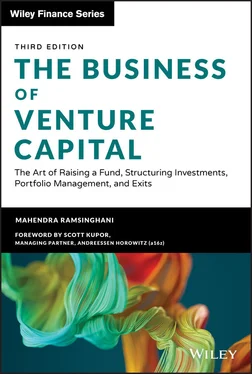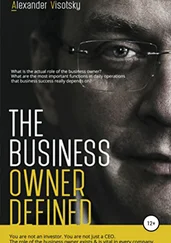Limit of Liability/Disclaimer of Warranty: While the publisher and author have used their best efforts in preparing this book, they make no representations or warranties with respect to the accuracy or completeness of the contents of this book and specifically disclaim any implied warranties of merchantability or fitness for a particular purpose. No warranty may be created or extended by sales representatives or written sales materials. The advice and strategies contained herein may not be suitable for your situation. You should consult with a professional where appropriate. Neither the publisher nor author shall be liable for any loss of profit or any other commercial damages, including but not limited to special, incidental, consequential, or other damages.
For general information on our other products and services or for technical support, please contact our Customer Care Department within the United States at (800) 762-2974, outside the United States at (317) 572-3993, or fax (317) 572-4002.
Wiley publishes in a variety of print and electronic formats and by print-on-demand. Some material included with standard print versions of this book may not be included in e-books or in print-on-demand. If this book refers to media such as a CD or DVD that is not included in the version you purchased, you may download this material at http://booksupport.wiley.com. For more information about Wiley products, visit www.wiley.com.
Library of Congress Cataloging-in-Publication Data
Names: Ramsinghani, Mahendra, author.
Title: The business of venture capital : the art of raising a fund, structuring investments, portfolio management, and exits / Mahendra Ramsinghani.
Description: Third edition. | Hoboken, New Jersey : John Wiley & Sons, Inc., [2021] | Series: Wiley finance series | Includes bibliographical references and index.
Identifiers: LCCN 2020030565 (print) | LCCN 2020030566 (ebook) | ISBN 9781119639688 (hardback) | ISBN 9781119639718 (adobe pdf) | ISBN 9781119639701 (epub)
Subjects: LCSH: Venture capital.
Classification: LCC HG4751 .R36 2020 (print) | LCC HG4751 (ebook) | DDC 332/.04154068–dc23
LC record available at https://lccn.loc.gov/2020030565
LC ebook record available at https://lccn.loc.gov/2020030566
Cover Design: Wiley
Cover Image: © piranka/Getty Images
Author Photo: Courtesy of Mahendra Ramsinghani
In the memory of my parents,who reminded me to putknowledge above wealth,people above profits,truth above power,and service above self
For Amar and Geeta, who gave me wings&for Deepa and Aria, who bring the light and the song
Now in its third edition, The Business of Venture Capital builds on the foundational best practices in venture investments, offering new, valuable tools along with some wit and wisdom. The scope of the venture capital business is wide, and often opaque. For example, how do our investors (limited partners or LPs) make decisions? What challenges do they encounter, and how should a general partner (GP) understand their universe? How can a practitioner build a “point of view” on the market, identify emerging trends, compete to win the best opportunities, and nurture them to success? What biases and cognitive traps spring up in our business? How should we think probabilistically? What skills are critical to our business, and how does one develop such skills? Which parts of our business are at the mercy of the markets?
In this book, you will find answers to many of these questions. But, as with any good book, it will leave you thinking about many other questions. You'll ultimately need to figure out how to apply many of the mental models about which Mahendra writes to your own situation.
Over the past decade, Mahendra has had to answer many of these questions, both as an investor and a practitioner. When the first edition was released nearly a decade ago, there was no book on VC and the blogosphere was just in its infancy. So, he heeded Nobel Prize winner Toni Morrison's advice: “If there's a book that you want to read, but it hasn't been written yet, then you must write it.”
This book includes views of over 50 leading LPs and GPs, compiled in a jargon-free, digestible format to benefit all those exploring VC as a path, whether you're a solo-GP getting ready to raise a fund or a venture partner on your first board.
This book covers the arc of investment and blends lessons from Silicon Valley as well as other parts of the country. Over the past decade, much has evolved — the amount of capital flowing in venture has increased tenfold by some estimates. Besides mainstream LPs, hedge funds, sovereign wealth funds, and corporate VC funds have helped shape this growth trajectory. At the same time, the presence of new and large players, including Softbank, have impacted the nature of the venture business overall.
Indeed, our business is changing rapidly and, with it, we continue to evolve. But our singular goal remains the same — to help entrepreneurs in their journey to build important and lasting businesses, along the way generating superior returns for our investors. It is my hope that this book will not only set the foundation for you but make a meaningful impact in your journey as a practitioner.
Scott Kupor
Author, Secrets of Sand Hill Road: Venture Capital and How to Get It
Managing Partner, Andreessen Horowitz (A16Z)
Former Chair, National Venture Capital Association (2017–2018)
Preface
WHY SHOULD YOU READ THIS BOOK?
Thank you, dear reader, for arriving at the doorsteps of this somewhat lengthy tome. I hope you reached here, at the doors of this career after some thought and planning, unlike me, who stumbled in the VC wormhole and got sucked in 20 years ago.
Do you really need a big, fat, expensive book on venture capital, when a thousand blogs can give you answers instantaneously? Surely, in this day and age of free content, why would you want to pay an ungodly amount to buy a book? And who has time to read these days?
And you must surely know, no book will teach you how to be a great investor — you have to get out there and start investing. Like learning to ride a bicycle. A book can only do so much. The learning comes from doing.
But what is the best way to become a good investor — to build a structured approach, to build your foundation, and to build a strong core? Maybe this book can help. The business of venture capital not only presents basic principles, checklists, and frameworks, but also shares philosophies and wisdom of the ages. At its very core, an investor has the ability to understand risk and then make a probabilistic bet against that risk. We do this to achieve outstanding “venture-like” returns, well above some other asset classes.
On the face of it, the business sounds easy. I mean — how hard can this be? As they say, any fool can write a check. Everybody knows the obvious of investing: “Buy low, sell high.” But how many can do it consistently across macroeconomic changes, with evolving technology cycles, competitive landscape, regulatory dynamics, and management teams? The sands of time keep shifting. Entropy prevails. All that is valuable is being eroded by the new waves. Your role as an investor is to make sure you can stay balanced, find music in this cacophony, and find the right signal.
In public equities, trading strategies include a “momentum” driven approach. You invest in a stock that has a high level of buy–sell activity. This momentum drives the price. In a frenzy, everyone jumps in and the price starts to go up, but very few pause to step away from the herd. To ask, “Why is this happening?” is not the mind-set of the momentum investor. They are well trained to make several short trades and know when to get in, when to get out. The “value” investor — someone like Warren Buffett — studies the company's financials, its value proposition, the ins and outs of the sector, competition, product pricing, defensible moats, and more. The intellectual effort for understanding value is much more different and strenuous than the herd mentality momentum-based trade. Bear in mind that we are not here to make moral judgments against momentum trades nor demonstrate superiority of any kind — we are merely choosing a path, based on our strengths to get to a destination. I was a herd trader, too, until I could develop my own muscles and confidence. Success can come from many paths, and you have to choose what works best for you. I have tried both approaches and can tell you one is far easier than the other, but the rewards of a well-planned strategy are immensely gratifying — both intellectually and financially. It is like a game of chess — only in this case, you have n number of opponents.
Читать дальше












